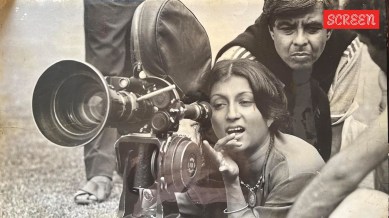Click here to follow Screen Digital on YouTube and stay updated with the latest from the world of cinema.

Parama : A Journey With Aparna Sen is a lively portrait of an artiste, with conversations that the director conducts with his subject, and her subjects. It begins, aptly, with a sequence from Sen’s first directorial, ‘36, Chowringhee Lane’, a 1981 film that brings alive a slice of Calcutta long since vanished. Violet Stoneham, played unforgettably by Jennifer Kendal, is an Anglo-Indian-school teacher-spinster who lives alone. An accidental meeting with a former student and her boyfriend injects warmth and colour into her drab life, but the change is sadly short-lived.
Ghosh and his team take Sen to the building — the kind in which the lifts didn’t work, the bare tangle of electricity wires hanging dangerously low over the staircase — in which the film was shot, and we hear her reminisce about how one of her best films, and one whose portrayal of loneliness still aches, came together.
It could almost be seen as producer Shashi Kapoor’s home movie (with performances by wife Jennifer and father-in-law Geoffrey Kendal, and children Sanjana and Karan Kapoor) along with Debashree Roy, Dhritiman Chatterjee, and Soni Razdan. Shot by that magician lensman Ashok Mehta, with artwork by the peerless Bansi Chandragupta, ‘36, Chowringhee Lane’ became an instant classic.
The act of remembering which cinema evokes so effectively is at play in these portions where the filmmaker’s memories create a bridge with the film she made so long back. Locating the large ‘baari’ where the 1985 ‘Parama’ was shot becomes a way of showing us how Sen’s presence with Ghosh’s crew is enough for them to enter the house, ‘no permission needed’.
The film about a dutiful Bengali housewife who becomes aware of her own self, starred Rakhee — who never did manage to shed her innate Bengali-ness through her long career in Hindi cinema– in a role she fit in beautifully. Standing at the spot where Parama leapfrogs over a puddle, being observed by the raffish photojournalist played by Mukul Sharma (Sen’s ex-husband, and the father of their daughters Kamalini and Konkona), Sen brings alive the joys of the film that was far ahead of its times, and the stir it caused amongst the Bengali ‘bhadralok’, both in and out of the film.
Fittingly, both Kamalini and Konkona are in the documentary, the former who remembers her mother acting in mainstream cinema simply to pay the bills and ‘put food on the table’, and her directorial era, in which she truly came alive. Konkona recalls how she wasn’t allowed to watch Doordarshan epics even as the girls in her class were deep in those weekly doses which had the nation in thrall at the time: according to her mother, it would have stunted the imagination. She was encouraged, as an alternative, to watch world cinema, getting familiar with such directors as Fellini and Antonioni.
Shabana Azmi appears in a chunk, and speaks of her films with Sen. She also talks of how in her later films (Ghawrey Baire Aaj), the ‘cause’ she is seeking to explore seems to overpower Sen’s filmmaking. In Indian films where even the slightest critique is seen as a slight, this kind of assessment is refreshing.
We see snippets from the Konkona Sen Sharma-Rahul Bose starrer ‘Mr and Mrs Iyer’, Sen’s sharp political pivot in 2002, when calling out the rising communalism and bigotry could be done much more safely. Konkona speaks of how her mother ‘tricked’ her into accepting the role of the South Indian housewife-and-mother; later, Bose has a sharp rejoinder on how a personal decision to participate, or not, in political acts cannot be the judge of character, the case in point being a letter signed by artists in 2019 on the rising intolerance in the country.
We see some others, including filmmaker Goutam Ghose, and husband Kalyan Ray, speak of Sen and her work. A few glimpses of her early acting work are also here (a striking scene from the 1970 James Ivory film ‘Bombay Talkie’ with Shashi Kapoor), as is her stint as the editor of ‘Sananda’, a magazine which was meant to break away from the hidebound content prevalent at the time: one of the pieces, which made a lot of noise, was about how abortion should be made legal.
Watch Parama A Journey With Aparna Sen trailer:
I missed a discussion around one of Sen’s most powerful films, ‘15, Park Avenue’ (2005), which should be made imperative viewing for those concerned with mental health, and how behaviour ‘out of the norm’ impacts family members and caregivers.
Also, we don’t really get to see how Sen with her strong feminist gaze was positioned in Bengali cinema, the tides that she had to swim against to get to the point where she became a director, and the impact that her work made on younger filmmakers. With her, in a fleeting frame, is Rituparno Ghosh, whose empathy, preoccupation with strong women and non-binary characters, melding of the personal and political in his chamber dramas, reminded you of Sen’s work. But there’s no attempt at exploring connections, similarities, disparities with the filmmakers who are working in Bengal today. Perhaps that would have widened the scope of this 86-minute documentary; perhaps that would, or could, be another film.
Parama A Journey With Aparna Sen director: Suman Ghosh
Parama A Journey With Aparna Sen rating: 3 stars
Click here to follow Screen Digital on YouTube and stay updated with the latest from the world of cinema.